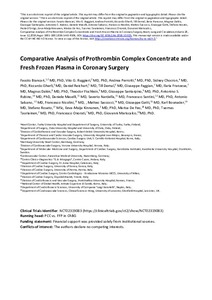Comparative Analysis of Prothrombin Complex Concentrate and Fresh Frozen Plasma in Coronary Surgery
Gherli Riccardo; Nicolini Francesco; Dalén Magnus; Franzese Ilaria; Saccocci Matteo; Mariscalco Giovanni; Tauriainen Tuomas; D’Errigo Paola; Onorati Francesco; Maselli Daniele; De Feo Marisa; Salsano Antonio; Demal Till; Santarpino Giuseppe; Rosato Stefano; Perrotti Andrea; Rubino Antonino S.; Biancari Fausto; Kinnunen Eeva-Maija; Gatti Giuseppe; Ruggieri Vito G.
https://urn.fi/URN:NBN:fi-fe2021042824628
Tiivistelmä
Background
Recent studies suggested that prothrombin complex concentrate (PCC) might be more effective than fresh frozen plasma (FFP) to reduce red blood cell (RBC) transfusion requirement after cardiac surgery.
Methods
This is a comparative analysis of 416 patients who received FFP postoperatively and 119 patients who received PCC with or without FFP after isolated coronary artery bypass grafting (CABG).
Results
Mixed-effects regression analyses adjusted for multiple covariates and participating centres showed that PCC significantly decreased RBC transfusion (67.2% vs. 87.5%, adjusted OR 0.319, 95%CI 0.136–0.752) and platelet transfusion requirements (11.8% vs. 45.2%, adjusted OR 0.238, 95%CI 0.097–0.566) compared with FFP. The PCC cohort received a mean of 2.7 ± 3.7 (median, 2.0, IQR 4) units of RBC and the FFP cohort received a mean of 4.9 ± 6.3 (median, 3.0, IQR 4) units of RBC (adjusted coefficient, −1.926, 95%CI −3.357–0.494). The use of PCC increased the risk of KDIGO (Kidney Disease: Improving Global Outcomes) acute kidney injury (41.4% vs. 28.2%, adjusted OR 2.300, 1.203–4.400), but not of KDIGO acute kidney injury stage 3 (6.0% vs. 8.0%, OR 0.850, 95%CI 0.258–2.796) when compared with the FFP cohort.
Conclusions
These results suggest that the use of PCC compared with FFP may reduce the need of blood transfusion after CABG.
Kokoelmat
- Rinnakkaistallenteet [19218]
